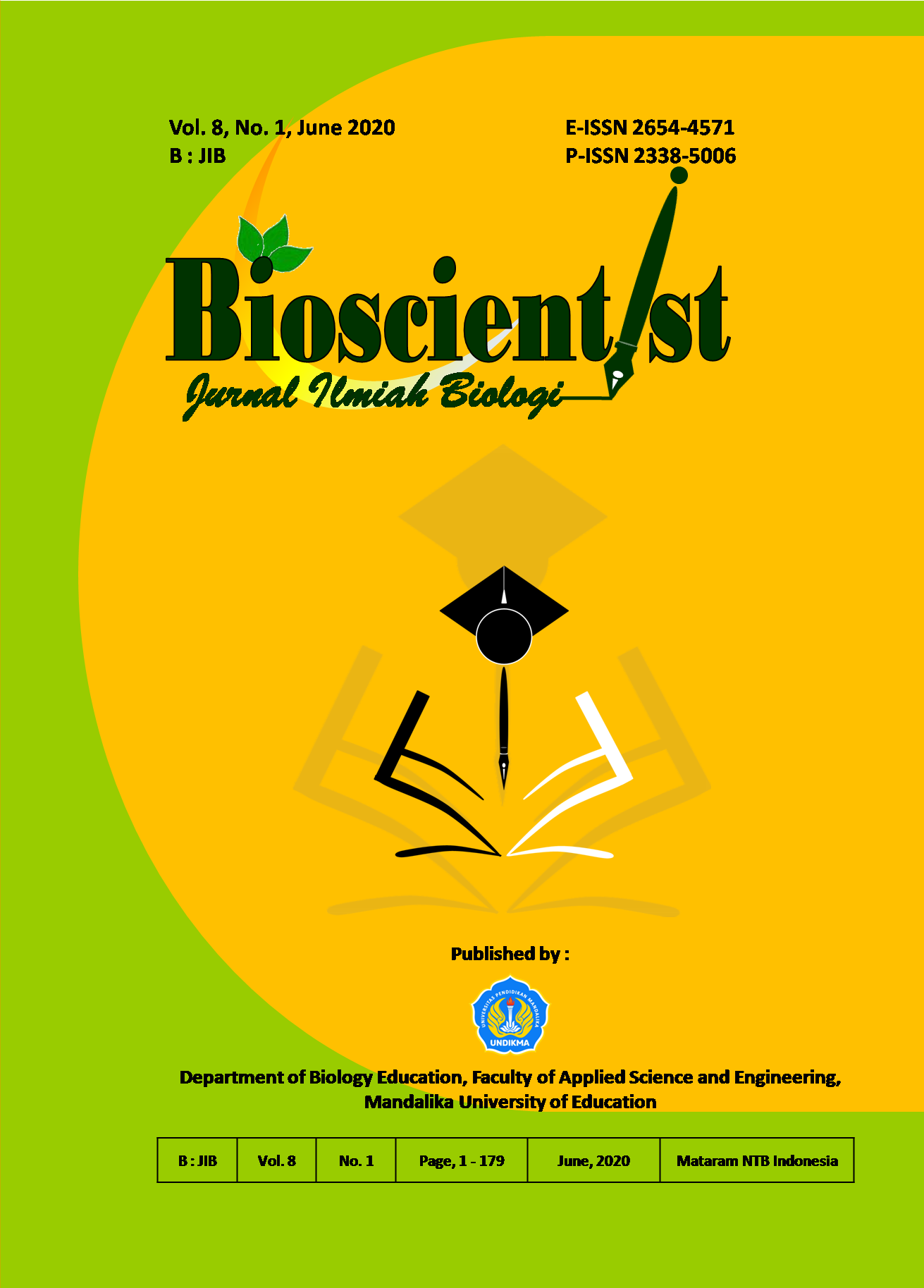ANALISIS FITOKIMIA DAN UJI POTENSI EKSTRAK BUAH RENGGAK (Amomum Dealbatum) SEBAGAI PESTISIDA NABATI TERHADAP JAMUR Pyricularia Oryzae DAN BAKTERI Xanthomonas oryzae
DOI:
https://doi.org/10.33394/bioscientist.v8i1.2661Keywords:
Renggak (Amomum dealbatum), Bio Pesticide, Pyriclaria oryzae, Xanthomonas oryzae.Abstract
This study aims to determine the potency of Renggak (Amomum dealbatum) extract as bio pesticide against Pyricularia oryzae and Xanthomonas oryzae. Therefore an in vitro of antifungal and antibacterial activity of the Renggak ethanol extract were carried out against Pyricularia oeyzae and Xanthomonas oryzae. In vitro antifungal analysis were done using agar diffusing method by dissolving Renggak extract (1%, 5%, and 10%) into fungal medium and the growth of Pyricularia oryzae were observed. In vitro antibacterial analysis were complited using agar diffusing method with paper disk that contain Renggak extract (10%, 20%, and 30%) and antibiotic chloroamfenikol as positive control. The result suggest that Renggak fruit extract has antifungal and antibacterial activities. The treatment with 10% Renggak extract could inhibit the growth of Pyricularia oryzae to 100%, same with positive control (Fungicide Score-250). In vitro test for antibacterial activity showed that treatments with 20% and 30% Renggak extract gave inhibitory activities that similar with positive control. Renggak ethanol extract gave positive results on Flavonoid, Alkaloid, Steroid, Terpenoid, and Saponin tests. GC-MS assays showed that Renggak ethanol extract produces at least 10 organic compounds that was identified as  2-butanone, 4-methoxypheyl, Benzenepropanoic-aci, 4-hydroxyphenil, CAS, octadecanoid acid, stearic acid, palmiti acid, Benzenepropanoic acid, dan Farnesol isomer A, which have antimicrobial avtivities.References
Anonim. (2014). Retrieved May 20, 2017, from http://tropical.theferns.info/viewtropical.php?id=Amomum+dealbatum.
Astiti, N. P. A., & Suprapta, D. N. (2012). Antifungal Activity of Teak (Tectona grandis L.F.) Leaf Extract Against Arthrinium Phaeospermum (Corda) M. B. Ellis. The Cause of Wood Decay on Albizia falcataria (L.) Fosberg. J.ISSAAS, 18(1), 62-69.
Astuti, H. (2015). Uji Aktivitas Antibakteri Ekstrak Ethanol dan Ekstrak Air Daun Bandotan (Ageratum conyzoides, L.) terhadap staphylococcus aureus dan Escherichia coli. Majalah Farmaseutik, 11(1), 290-293.
Brilhante, R. S. N., Valente, L. G. A., Rocha, M. F. G., Bandeira, T. J. P. G., Cordeiro, R. A., Lima, R. A. C., Leite, J. J. G., Ribeiro, J. F., Pereira, J. F., Castelo-Branco, D. S. C. M., Monteiro, A. J., & Sidrim, J. J. C. (2012). Sesquiterpene Farnesol Contributes to Increased Susceptibility to-Lactams in Strains of Burkholderia pseudomallei. Antimicrobial Agents and Chemotherapy, 56(4), 2198-2200.
Cotoras, M., Castro, P., Vivanco, H., Melo, R., & Mendoza, L. (2013). Farnesol Induces Apoptosis-Like Phenotype in the Phytopathogenic Fungus Botrytis Cinerea. Mycologia, 105(1), 28-33.
Desbois, A. P., & Smith, V. J. (2010). Antibacterial Free Fatty Acids: Activities, Mechanisms of Action and Biotechnological Potential. App. Microbial Biotechnology, 85(6), 1929-1942.
Egbe, N. E., Dornelles, T. O., Paget, C. M., Castelli, L. M., & Ashe, M. P. (2012). Farnesol Inhibits Translation to Limit Growth and Filamentation in C. albicans and S. cerevisiae. Microbial Cell, 4(9), 295-304.
Haque, M. D., Liu, L., Amayah, A. T. (2016). The Role of Vision in Organizational Readiness for Change and Growth Leadership & Organization. Development Journal, 37(7), 983-999.
Hasanudin, W., Nuryani, E., Silvia, I., Djatnika, & Marwoto, B. (2010). Formulasi Biopestisida Berbahan Aktif Bacillus subtilis, Pseudomonas fluorescens, dan Corynebacterium sp. Nonpatogenik untuk Mengendalikan Penyakit Karat pada Krisan. Jurnal Hortikultura, 20(3),247-261.
Kamazeri, T. S., Samah, O. A., Taher, M., Susanti, D., & Qaralleh, H. (2012). Antimicrobial Activity and Essential Oils of Curcuma aeruginosa, Curcuma mangga, and Zingiber cassumunar from Malaysia. Asian Pacific Journal of Tropical Medicine. 5, 202-209.
Kumar, G., Baby, C., & Mohammed, A. (2012). Amomum subulatum Robx : An Overview on All Aspect. Research Journal on Pharmacy, 3(7), 96-99.
Langford, M. L., Hasim, S., Nickerson, K. W., & Atkin, A. L. (2010). Activity and Toxicity of Farnesol Towards Candida albicans are Dependent on Growth Conditions. Antimicrob Agents Chemother, 54(2), 940-942.
Moghadamtousi, S. Z., Kadir, H. A., Hassandarvish, P., Tajik, H., Abubakar, S., & Zand, K. (2014). A Review on Antibacterial, Antiviral, and Antifungal Activity of Curcumin. Biomed Reseacrh International, (A Special Issue), 1-12.
Sudir, Nasution, A., Santoso, & Nuryanto, B. (2014). Penyakit Blas Pyricularia grisea pada Tanaman Padi dan Strategi Pengendaliannya. Iptek Tanaman Pangan, 9(2), 85-96.
Orhan, D. D., Özgen, S., Özçelik, B., & Ergun, F. (2009). Antibacterial, Antifungal, and Antiviral Activities of Some Flavonoids. Microbiological Research, 165(6), 496-504.
Pohl, C. H., Kock, J. L., & Thibane, V. S. (2011). Antifungal Free Fatty Acids: a Review. Sci. Microb. Pathog. Curr. Res. Technol. Adv, 1, 61-71.
Sumartini. (2016). Biopestisida untuk Pengendalian Hama dan Penyakit Tanaman Aneka Kacang dan Umbi. Iptek Tanaman Pangan, 11(2), 159-166.
Tabti, L., Dib, M. E. A., Benyelles, N. G., Djabou, N., Alam, S. B., Paolini, J., Costa, J., & Muselli, A. (2015). Fatty-Acid Composition and Antifungal Activity of Extracts of Thymus capitatus. Journal of Herbs, Spices, & Medicinal Plants, 21, 203-210.
Tripathi, M., Upadhyay, R., Chawla, P., & Trivedi, S. (2013). Essential Oils from Family Zingiberaceae for Antimicrobial Activity-a Review. International Journal of Pharma and Bio Sciences, 4(4), 149-162.
Xing, M., Zheng, L., Deng, Y., Xu, D., Xi, P., Li, M., Kong, G., & Jiang, Z. (2018). Antifungal Activity of Natural Volatile Organic Compounds Against Litchi Downy Blight Pathogen Peronophythora litchi. Molecules, 23(2), 358.













